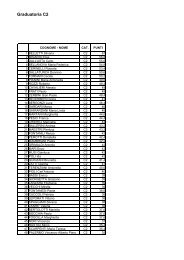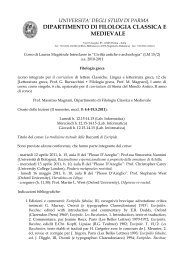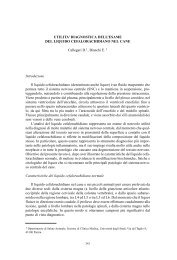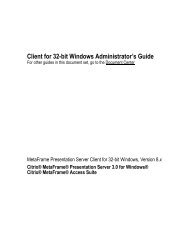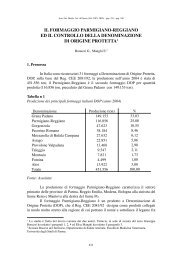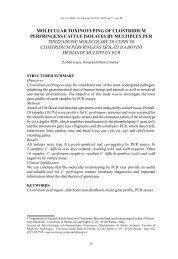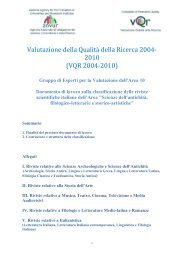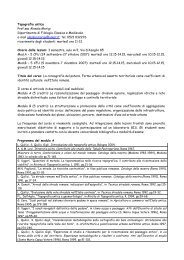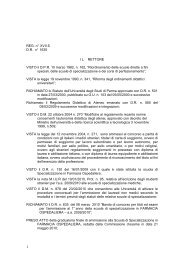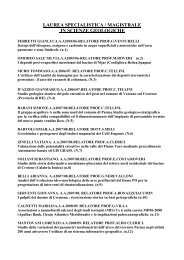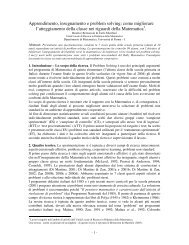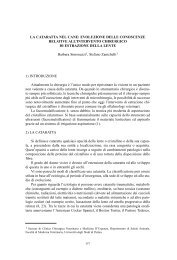Prevalence of Clostridium sPP. in diarrhoeic and healthy dogs ...
Prevalence of Clostridium sPP. in diarrhoeic and healthy dogs ...
Prevalence of Clostridium sPP. in diarrhoeic and healthy dogs ...
Create successful ePaper yourself
Turn your PDF publications into a flip-book with our unique Google optimized e-Paper software.
Ann. Fac. Medic. Vet. di Parma (Vol. XXVII, 2007) pag. 143 - pag. 156C. difficile is a significant enteropathogen <strong>in</strong> human be<strong>in</strong>gs <strong>and</strong> horses, where<strong>in</strong>fection is most commonly associated with disruption <strong>of</strong> the normal micr<strong>of</strong>lora,followed by colonization by toxigenic stra<strong>in</strong>s. The role that this microrganism plays<strong>in</strong> <strong>dogs</strong> is not well def<strong>in</strong>ed, <strong>and</strong> only a few studies evaluat<strong>in</strong>g the presence <strong>of</strong> tox<strong>in</strong>s<strong>in</strong> <strong>diarrhoeic</strong> <strong>and</strong> non-<strong>diarrhoeic</strong> animals have been done [7].There is no consensus between veter<strong>in</strong>ary diagnostic laboratories regard<strong>in</strong>gdiagnosis <strong>of</strong> C. difficile-associated diarrhoea <strong>in</strong> the dog. The apparently highprevalence <strong>of</strong> ELISA-positive, culture-negative can<strong>in</strong>e specimens obta<strong>in</strong>ed withsome assays is questionable, consider<strong>in</strong>g that these commercial assays have neverbeen validated <strong>in</strong> the dog; therefore, such data may represent the consequence <strong>of</strong>false-positive results [7].Ideally, the application <strong>of</strong> PCR assays directly on <strong>diarrhoeic</strong> fecal specimens<strong>and</strong>/or on C. difficile isolated stra<strong>in</strong>s for the detection <strong>of</strong> tox<strong>in</strong> A <strong>and</strong> B genes comb<strong>in</strong>edwith ELISA tests for the demonstration <strong>of</strong> tox<strong>in</strong> production (<strong>in</strong> vivo <strong>and</strong> <strong>in</strong> vitro)should be implemented for diagnos<strong>in</strong>g can<strong>in</strong>e CDAD.AcknowledgementsThe authors wish to thank Mrs C<strong>in</strong>zia Reverberi <strong>and</strong> Mr. Roberto Lurisi for theirtechnical support.R<strong>in</strong>graziamentiSi r<strong>in</strong>grazia la sig.ra C<strong>in</strong>zia Reverberi ed il sig. Roberto Lurisi per l’assistenza tecnicaprestata.References1. Batt R.M., Rutgers C. (1997) Bacteria <strong>and</strong> <strong>in</strong>test<strong>in</strong>al disease <strong>in</strong> <strong>dogs</strong>. GDBATechnical Review no 11. UK.2. Baums C.G., Shotte U., Amtsberg G., Goethe R. (2004) Diagnostic multiplexPCR for tox<strong>in</strong> genotyp<strong>in</strong>g <strong>of</strong> <strong>Clostridium</strong> perfr<strong>in</strong>gens isolates. Vet. Microbiol.,100: 11-16.3. Chouicha N., Marks S.L. (2006) Evaluation <strong>of</strong> five enzyme immunoassayscompared with the cytotoxicity assay for diagnosis <strong>of</strong> <strong>Clostridium</strong> difficileassociateddiarrhea <strong>in</strong> <strong>dogs</strong>. J. Vet. Diagn. Invest., 18: 182-188.4. Fach P., Pop<strong>of</strong>f M.R. (1997) Detection <strong>of</strong> enterotoxigenic <strong>Clostridium</strong> perfr<strong>in</strong>gens<strong>in</strong> food <strong>and</strong> fecal samples with a duplex PCR <strong>and</strong> the slide latex agglut<strong>in</strong>ationtest. Appl. Environ. Microbiol., 63: 4232-4236.5. Hackett T., Lapp<strong>in</strong> M.R. (2003) <strong>Prevalence</strong> <strong>of</strong> enteric pathogens <strong>in</strong> <strong>dogs</strong> <strong>of</strong>North-Central Colorado. J. Am. Anim. Hosp. Assoc., 39: 52-56.6. Marks S.L. (2003) Bacterial gastroenteritis <strong>in</strong> <strong>dogs</strong> <strong>and</strong> cats. In Proceed<strong>in</strong>gs<strong>of</strong> 28 th World Congress <strong>of</strong> the World Small Animal Veter<strong>in</strong>ary Association.Bangkok, Thail<strong>and</strong>, October 24-27, 2003.7. Marks S.L., Kather E.J. (2003) Bacterial-associated diarrhea <strong>in</strong> the dog: a criticalappraisal. Vet. Cl<strong>in</strong>. Small Anim., 33: 1029-1060.8. Marks S.L., Kather E.J. (2003) Antimicrobial susceptibilities <strong>of</strong> can<strong>in</strong>e154



